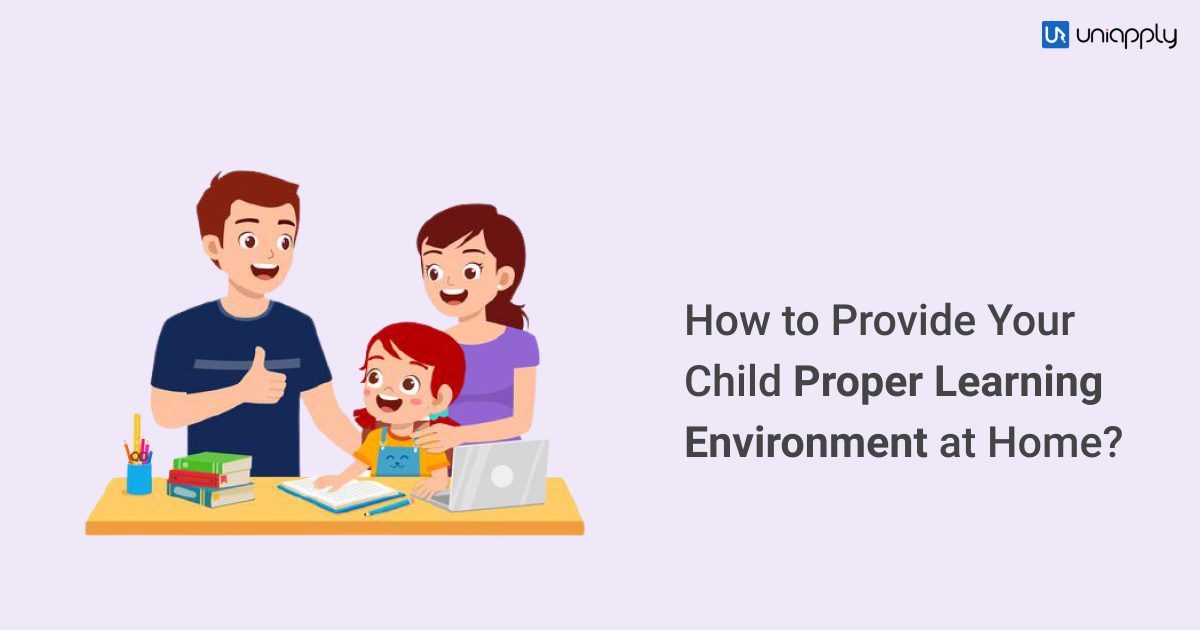How to Provide your Child with a Proper Learning Environment at Home?
School is essential for a child’s growth, and that’s why every parent tries to find the best schools for their children. However, sending your child to the best school doesn’t release you from your parental contribution to the educational growth of your child & support your child’s learning at home.
You are required every single day to monitor and help your child in their school activities. There is a sense of pressure among the parents, especially those with young children, who may need support. It is very important to continuously foster your child’s educational experience at home and to deliver a rich environment for learning. Therefore, there is a need for a thorough understanding of the child’s stages of development. Taking this into consideration, we have put together a list of approaches that will help parents in setting up a perfect learning environment at home.
- Build Schedules that Foster Individuality: Parents should work along with their children to make them understand the value of individuality and independence. You need to release some control and embrace the chaos to let your child learn at home. Planning of routines can help in ownership for younger students. Devote the first few weeks creating procedures and routines, and then slowly let your kid decide his/her schedule. To make your child get organized, make a daily board of tasks. You can divide it into three categories: to do, doing, and done. Place this up at the beginning of each class for your child and help them in taking one task and change it from “to do” to “doing” and, then eventually, “done”.
- Eliminate all Distractions: Tell your child to switch off their phone when they are learning at home and turn off the TV as well. For grownup children, you might want to remove some apps and tools that might help in eliminating distractions and install some apps to increase their concentration. You can try playing some instrumental music just to overpower other noises. Few parents find this useful and some do not. So, you can decide accordingly if your child enjoys mild instrumental music in the background or not.
- Make it Comfortable: Select a comfortable chair for your children so that they can comfortably sit for longer periods, and ensure that they have a flat surface or a desk that can accommodate their notebooks, books, laptops and other learning materials. We don’t recommend the usage of a bed as an educational space; so that your child should not fall asleep in between their lessons! Also, studies suggest doing things other than sleeping in bed might lead to trouble falling asleep at bedtime.
- Ensure the Learning Space has Plenty of Lighting: This could include lighting from lamps or natural lighting from windows. Research shows that children learn better in natural lighting than artificial one. It also lifts the spirits and helps in producing Vitamin C and maintaining Vitamin D levels in the human body.
- Have all of your Child’s Learning Supplies Easily Accessible: Always Encourage your kid to keep their corners clutter-free and organized. Keep all your child’s study material and stationery supplies easily accessible in their study corner. Maybe you could give a small prize each week if they are successful in keeping their space clutter-free and tidy. Moreover, you can give each youngster a box to store and organize their study materials.
Important Tips for Online Class Management at Home and your Child’s Physical and Mental Health
Online classes can be messy and tedious. Your child has to go through the daily exposure of blue-light emission from laptop/mobile screens. This in the long run would affect their mental as well as physical health. In order to keep a check on your child’s health, you can follow these tips:
- Fix a schedule: Ensure that you are not overexposing your child to devices and giving them enough time to do other activities such as playing, reading storybooks, etc. Encourage them to do more offline activities. You can motivate them to pursue hobbies such as painting and drawing, dance, music. This will give them a break from the screen time.
- Snack Breaks: During their snack breaks, avoid discussing class and school-related things. Instead, let them use this time as a full break from school.
- Ensure they are physically as well as mentally healthy: Encourage your child to engage in physical activities. If they can’t go out, look out for some indoor activities that can boost their metabolism. Moreover, give them some personal space so that they can have some personal time for themselves.
- Communicate like a friend: We know you have to groom your child and for that, you need to be strict sometimes. However, you should also try to understand their point of view. Talk to them about your problems and also let them share their problems with you.
Keep in mind that home learning is there to consolidate your child’s knowledge and their essential learning takes place at school, so try not to be stressed. Always remember that each child is different and as their parent, you need to learn how to reach out to them. Simply give them your attention, time and love and ensure, as often as you can, that you share healthy, productive activities and a friendly, loving home environment. We hope you find these suggestions helpful.
Also Read:
CBSE Declares Special Assessment Scheme for Classes X, XII for the Session 21-22
460 Pvt Schools to Collect Fees With a 15% Reduction Only on Monthly Basis: Delhi Govt.
Guidelines for CBSE Class 12: Result will be declared on July 31






